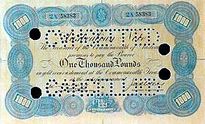Argentina's government will issue a new 100 peso ($22) note bearing an image of former First Lady
Eva Peron to mark the 60th anniversary of her death today.
President Cristina Fernandez de Kirchner, an admirer of the woman known to Argentines as Evita, said the template for the new bill was rescued from a 1952 design of a 5-peso note that was hidden for years at the country’s mint. The note was banned from ever circulating by the military junta that toppled Evita’s husband, former President Juan Domingo Peron, in a 1955 coup.
“Eva wasn’t perfect, she wasn’t a saint, but rather a woman of humble origin who found herself with a man and with a people,” Fernandez, whose own rise to power began alongside her deceased husband, former President Nestor Kirchner, said yesterday.
The government’s unveiling of the Evita peso bill comes as Argentines have been dumping their currency in favor of theU.S. dollar to ward against stalling growth in South America’s second-biggest economy and inflation that private economists estimate at 24 percent.
Since her re-election in October, Fernandez has imposed foreign exchange limits to stem capital flight that last year doubled to $21.5 billion. Her ban on most foreign currency purchases by individuals has forced argentines to turn to the unregulated market, driving up the dollar to 6.79 pesos, a 48 percent premium over the official rate.
Peronist Icon
Evita remains an icon of the ruling Peronist party, emblazoning banners at pro-government rallies where Fernandez frequently invokes her legacy as a champion of the poor.
To mark the anniversary of her death from cancer at the age of 33, Fernandez last yearinaugurated a 15-ton, 100-foot iron portrait of Evita that hangs from the side of the Social Development ministry along Buenos Aires’ busiest avenue.
Speaking yesterday from the presidential palace with a scale model of that mural behind her, Fernandez said that authorities had first wanted to honor Evita with a commemorative issue of banknotes worth 20 million pesos. The idea caught on and Fernandez said that she’s now ordered authorities to use her likeness to replace that of former President Julio Argentino Roca on all future printings of the 100-peso bills.
Roca served two terms as president after leading an 1878 military campaign of extermination against Indian groups known as the Conquest of the Desert, which cleared the way for settlement of the country’s hinterland.
“Eva Peron gives a sense of peace and tranquility,” Fernandez said.


